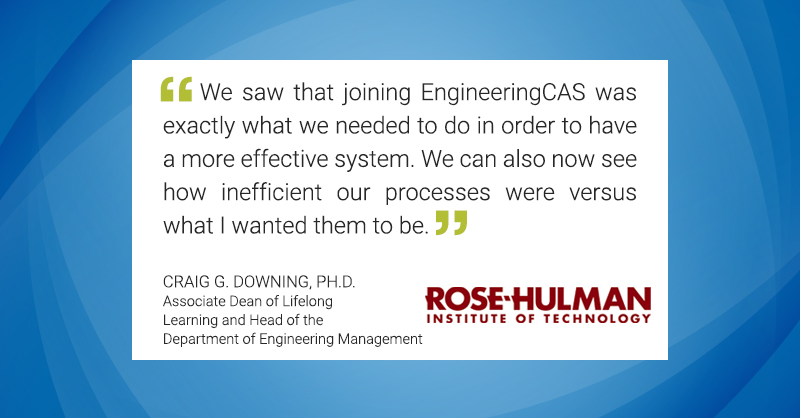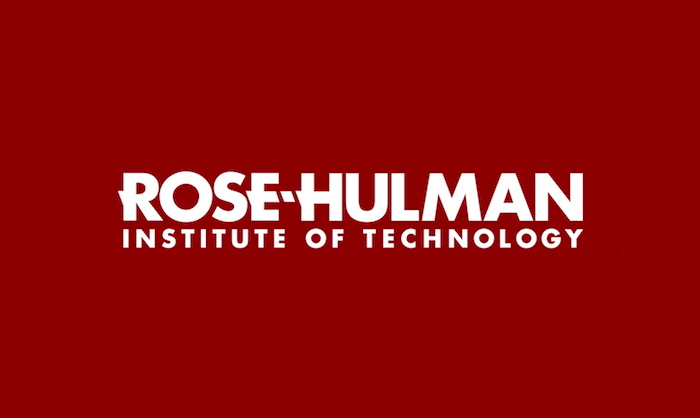
Before Rose-Hulman Institute of Technology (RHIT) joined Liaison’s EngineeringCAS™, application processing and enrollment management were handled through “pencil and paper, literally,” recalls Craig G. Downing Ph.D., associate dean of Lifelong Learning and head of the Department of Engineering Management.
Now, RHIT’s only remaining hard copies — backup records on students following their admission — are “ripe for the shredder in the next year,” he says.
EngineeringCAS brings admissions offices an improved way to recruit, enroll and admit best-fit engineering students while saving money and better allocating staff resources each admissions cycle. Its platform is the manifestation of one of Liaison’s partnerships with over 30 professional associations across academic disciplines; these partnerships have each introduced discipline-specific versions of Liaison’s Centralized Application Service (CAS™), the cloud-based student admissions solution that has helped over 31,000 programs on more than 1,000 campuses optimize their application and enrollment processes. All CASs are available at no cost to participating programs.
But what exactly is EngineeringCAS?
For applicants, it offers a single portal which streamlines their process for researching and applying to multiple programs of interest, offers a modern application experience that guides them through the process and provides 24/7 access to real-time application status updates.
For programs and institutions, EngineeringCAS drives awareness of engineering programs through a streamlined application process and communication tools that enable targeted, personalized communications to those interested in a program; decreases decision-making times by providing a processing team to scan transcripts and package application components as an extension of an admissions staff; and provides insight into enrollment trends and performance on a campus through robust analytics and reporting tools.
Indiana-based RHIT had limited experience with an online application before joining EngineeringCAS, but the previous system fell short of Downing’s expectations.
“Students would ask for an application and they would stop by and get one, or we’d mail it out to them,” he says. “Then we transitioned to using an electronic application through our Banner system. That system was a bit clunky because it required some verifications and credentials which an outside student wouldn’t have.”
RHIT had also lacked the potential insights that its admissions operation could gain from comparative data on previous years.
“I did not know any characteristic of my enrollment funnel. I did not know my melt rate. I didn’t have a yield strategy. I couldn’t tell you what our typical yield was in any particular year,” Downing says. “I couldn’t give you snapshots on how many students had enrolled at any point in time within the process. I couldn’t take a snapshot in December, in January or in February and then tell anybody.”
Adding insult to injury, since Downing is a process engineer by trade, RHIT’s leadership all specifically expected him to produce the aforementioned data points.
“They were really looking for me to provide a process that yielded useful, actionable data,” he says.
After initially receiving an email about EngineeringCAS from a colleague in the mechanical engineering sector, Downing consulted with leaders at the American Society of Mechanical Engineers (ASME) and the American Society for Engineering Education (ASEE), two of the professional associations which partner with Liaison. He also participated in a webinar about EngineeringCAS.
Today, Downing is not only a user of EngineeringCAS, but is also a member of its advisory board.
“We saw that joining EngineeringCAS was exactly what we needed to do in order to have a more effective system. We can also now see how inefficient our processes were versus what I wanted them to be,” he says. Downing also notes that some alternative solutions which RHIT explored at the time weren’t capable of building a customized module for what the school needed in its applications.
During RHIT’s first admissions cycle using EngineeringCAS, Downing is already witnessing the benefits of a tighter process driven by automation, allowing his team to save days of time. His aspiration is that by the end of this cycle, RHIT will have cut application processing and decision-making times in half.
“I want to drop our metric for turnaround time from 10 to 5 business days,” he says. “I think we’re doing a disservice not only to the students, but also to the process as a whole by holding that data and not making a decision.”
Yet saving time is just the start. Downing envisions sweeping systemic change as a result of using a CAS.
“I wanted greater transparency. I wanted greater accountability. I wanted greater information. And I wanted access,” he says. “During the summertime we sometimes get late applications, but often some of our staff — me included — are on the road or traveling internationally. I don’t think that should stop us from being able to do business.”

Downing also believes that EngineeringCAS will address not only his admissions operation’s costs, but also its opportunity costs.
“That one-stop, web-enabled cloud-based system was something we did not have in the past,” he says. “I don’t know how many students we may have lost or how much frustration we may have introduced by waiting for an applicant to physically come to our office to get a file, to then review the file, to then send that file back to us through campus mail.”
Looking ahead, Downing says he looks forward to eventually attending the Liaison User Conference in order to “talk with CAS users, administrators and other people in this community to find out what the best practices are, so that when we are capturing data, not only would we have data that we can compare internally, but also information that we can compare to others in the engineering graduate area.”
He adds, “I’m looking more at enrollment management and how EngineeringCAS can be used to better understand what my actions should be, and for those actions, what my yield potentially can be.”
